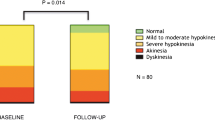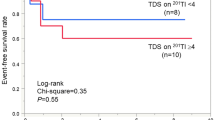Abstract
Purpose
18F-FDG PET is an important modality for myocardial viability assessment in patients with left ventricular (LV) dysfunction. Dual-isotope simultaneous acquisition (DISA) SPECT may be an alternative to PET. The aim of this study was to compare the diagnostic performance of PET and DISA SPECT for the prediction of improvement in regional and global LV function as well as LV reverse remodelling after revascularization.
Methods
Patients (n=47) with chronic coronary artery disease and LV dysfunction underwent DISA SPECT (with 99mTc-sestamibi and 18F-FDG) and PET (with 13N-ammonia and 18F-FDG) on the same day to assess viability. All patients underwent revascularization and recovery of function was derived from serial magnetic resonance imaging studies.
Results
Of 264 revascularized, dysfunctional segments, 143 (54%) improved in function. For prediction of improvement in regional LV function, PET and DISA SPECT had similar sensitivity (90% versus 89%, NS) and specificity (86% versus 86%, NS). For prediction of improvement in global LV function, sensitivity was 83% for DISA SPECT and 86% for PET (p=NS), whereas both modalities had a specificity of 100%. Finally, sensitivity and specificity for the prediction of LV reverse remodelling were also similar for DISA SPECT and PET.
Conclusion
In patients undergoing revascularization, DISA SPECT and PET predict the improvement in regional and global LV function and LV remodelling equally well post revascularization.






Similar content being viewed by others
References
Tillisch J, Brunken R, Marshall R, Schwaiger M, Mandelkern M, Phelps M, et al. Reversibility of cardiac wall-motion abnormalities predicted by positron tomography. N Engl J Med 1986;314:884–8
Tamaki N, Kawamoto M, Tadamura E, Magata Y, Yonekura Y, Nohara R, et al. Prediction of reversible ischemia after revascularization. Perfusion and metabolic studies with positron emission tomography. Circulation 1995;91:1697–1705
Rizzello V, Poldermans D, Bax JJ. Assessment of myocardial viability in chronic ischemic heart disease: current status. Q J Nucl Med Mol Imaging 2005;49:81–96
Fukuchi K, Katafuchi T, Fukushima K, Shimotsu Y, Toba M, Hayashida K, et al. Estimation of myocardial perfusion and viability using simultaneous 99mTc-tetrofosmin-FDG collimated SPECT. J Nucl Med 2000;41:1318–23
Sandler MP, Videlefsky S, Delbeke D, Patton JA, Meyerowitz C, Martin WH, et al. Evaluation of myocardial ischemia using a rest metabolism/stress perfusion protocol with fluorine-18 deoxyglucose/technetium-99m MIBI and dual-isotope simultaneous-acquisition single-photon emission computed tomography. J Am Coll Cardiol 1995;26:870–8
Knuuti MJ, Yki-Jarvinen H, Voipio-Pulkki LM, Maki M, Ruotsalainen U, Harkonen R, et al. Enhancement of myocardial [fluorine-18]fluorodeoxyglucose uptake by a nicotinic acid derivative. J Nucl Med 1994;35:989–98
Schinkel AF, Bax JJ, Valkema R, Elhendy A, van Domburg RT, Vourvouri EC, et al. Effect of diabetes mellitus on myocardial 18F-FDG SPECT using acipimox for the assessment of myocardial viability. J Nucl Med 2003;44:877–83
De Boer J, Slart RH, Blanksma PK, Willemsen AT, Jager PL, Paans AM, et al. Comparison of 99mTc-sestamibi–18F-fluorodeoxyglucose dual isotope simultaneous acquisition and rest-stress 99mTc-sestamibi single photon emission computed tomography for the assessment of myocardial viability. Nucl Med Commun 2003;24:251–7
Hendel RC, Corbett JR, Cullom SJ, DePuey EG, Garcia EV, Bateman TM. The value and practice of attenuation correction for myocardial perfusion SPECT imaging: a joint position statement from the American Society of Nuclear Cardiology and the Society of Nuclear Medicine. J Nucl Cardiol 2002;9:135–43
Ficaro EP, Kritzman JN, Corbett JR. Development and clinical validation of normal Tc-99m sestamibi database: comparison of 3D-MSPECT to Cequal [abstract]. J Nucl Med 1999;40(suppl):125P
Metz CE. Basic principles of ROC analysis. Semin Nucl Med 1978;8:283–98
van der Geest RJ, Buller VG, Jansen E, Lamb HJ, Baur LH, van der Wall EE, et al. Comparison between manual and semiautomated analysis of left ventricular volume parameters from short-axis MR images. J Comput Assist Tomogr 1997; 21:756–65
Slart RH, Que TH, van Veldhuisen DJ, Poot L, Blanksma PK, Piers DA, et al. Effect of attenuation correction on the interpretation of 99mTc-sestamibi myocardial perfusion scintigraphy: the impact of 1 year s experience. Eur J Nucl Med Mol Imaging 2003;30:1505–9
Slart RH, Bax JJ, Sluiter WJ, van Veldhuisen DJ, Jager PL. Added value of attenuation-corrected Tc-99m tetrofosmin SPECT for the detection of myocardial viability: comparison with FDG SPECT. J Nucl Cardiol 2004;11:689–96
Van Lingen A, Huijgens PC, Visser FC, Ossenkoppele GJ, Hoekstra OS, Martens HJ, et al. Performance characteristics of a 511-keV collimator for imaging positron emitters with a standard gamma-camera. Eur J Nucl Med 1992;19:315–21
Bax JJ, Visser FC, Blanksma PK, Veening MA, Tan ES, Willemsen TM, et al. Comparison of myocardial uptake of fluorine-18-fluorodeoxyglucose imaged with PET and SPECT in dyssynergic myocardium. J Nucl Med 1996;37:1631–6
Burt RW, Perkins OW, Oppenheim BE, Schauwecker DS, Stein L, Wellman HN, et al. Direct comparison of fluorine-18-FDG SPECT, fluorine-18-FDG PET and rest thallium-201 SPECT for detection of myocardial viability. J Nucl Med 1995;36:176–9
Chen EQ, MacIntyre WJ, Go RT, Brunken RC, Saha GB, Wong CY, et al. Myocardial viability studies using fluorine-18-FDG SPECT: a comparison with fluorine-18-FDG PET. J Nucl Med 1997;38:582–6
Martin WH, Delbeke D, Patton JA, Hendrix B, Weinfeld Z, Ohana I, et al. FDG-SPECT: correlation with FDG-PET. J Nucl Med 1995;36:988–95
Srinivasan G, Kitsiou AN, Bacharach SL, Bartlett ML, Miller-Davis C, Dilsizian V. [18F]fluorodeoxyglucose single photon emission computed tomography: can it replace PET and thallium SPECT for the assessment of myocardial viability? Circulation 1998;97:843–50
Bax JJ, Patton JA, Poldermans D, Elhendy A, Sandler MP. 18-Fluorodeoxyglucose imaging with positron emission tomography and single photon emission computed tomography: cardiac applications. Semin Nucl Med 2000;30:281–98
Bax JJ, Cornel JH, Visser FC, Fioretti PM, Van Lingen A, Reijs AE, et al. Prediction of recovery of myocardial dysfunction after revascularization. Comparison of fluorine-18 fluorodeoxyglucose/thallium-201 SPECT, thallium-201 stress-reinjection SPECT and dobutamine echocardiography. J Am Coll Cardiol 1996;28:558–64
Bax JJ, Cornel JH, Visser FC, Fioretti PM, Van Lingen A, Huitink JM, et al. Prediction of improvement of contractile function in patients with ischemic ventricular dysfunction after revascularization by fluorine-18 fluorodeoxyglucose single-photon emission computed tomography. J Am Coll Cardiol 1997;30:377–83
Bax JJ, Cornel JH, Visser FC, Fioretti PM, Huitink JM, Van Lingen A, et al. F18-fluorodeoxyglucose single-photon emission computed tomography predicts functional outcome of dyssynergic myocardium after surgical revascularization. J Nucl Cardiol 1997;4:302–8
Cornel JH, Bax JJ, Fioretti PM, Visser FC, Maat AP, Boersma E, et al. Prediction of improvement of ventricular function after revascularization. 18F-fluorodeoxyglucose single-photon emission computed tomography vs low-dose dobutamine echocardiography. Eur Heart J 1997;18:941–8
Meluzin J, Cerny J, Frelich M, Stetka F, Spinarova L, Popelova J, et al. Prognostic value of the amount of dysfunctional but viable myocardium in revascularized patients with coronary artery disease and left ventricular dysfunction. Investigators of this Multicenter Study. J Am Coll Cardiol 1998;32:912–20
White HD, Norris RM, Brown MA, Brandt PW, Whitlock RM, Wild CJ. Left ventricular end-systolic volume as the major determinant of survival after recovery from myocardial infarction. Circulation 1987;76:44–51
Beanlands RS, Ruddy TD, deKemp RA, Iwanochko RM, Coates G, Freeman M, et al. Positron emission tomography and recovery following revascularization (PARR-1): the importance of scar and the development of a prediction rule for the degree of recovery of left ventricular function. J Am Coll Cardiol 2002;40:1735–43
Bax JJ, Schinkel AF, Boersma E, Elhendy A, Rizzello V, Maat A, et al. Extensive left ventricular remodeling does not allow viable myocardium to improve in left ventricular ejection fraction after revascularization and is associated with worse long-term prognosis. Circulation 2004;110:II18–22
Mule JD, Bax JJ, Zingone B, Martinelli F, Burelli C, Stefania A, et al. The beneficial effect of revascularization on jeopardized myocardium: reverse remodeling and improved long-term prognosis. Eur J Cardiothorac Surg 2002;22:426–30.
Bax JJ, Visser FC, Poldermans D, Elhendy A, Cornel JH, Boersma E, et al. Time course of functional recovery of stunned and hibernating segments after surgical revascularization. Circulation 2001;104:I314–8
Acknowledgements
This study was supported by an educational unrestricted research grant (COG-AZG 2000-06) of the Groningen University Medical Center, The Netherlands. Dr. D.J. van Veldhuisen is an Established Investigator of the Netherlands Heart Foundation (Grant D976.017).
Author information
Authors and Affiliations
Corresponding author
Rights and permissions
About this article
Cite this article
Slart, R.H., Bax, J.J., van Veldhuisen, D.J. et al. Prediction of functional recovery after revascularization in patients with chronic ischaemic left ventricular dysfunction: head-to-head comparison between 99mTc-sestamibi/18F-FDG DISA SPECT and 13N-ammonia/18F-FDG PET. Eur J Nucl Med Mol Imaging 33, 716–723 (2006). https://doi.org/10.1007/s00259-005-0016-z
Received:
Accepted:
Published:
Issue Date:
DOI: https://doi.org/10.1007/s00259-005-0016-z




